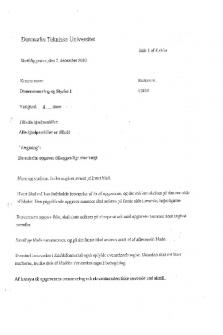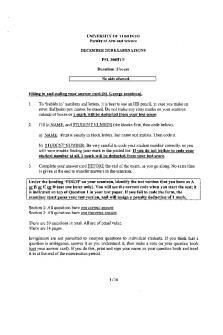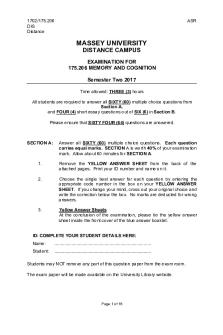Final 7 December, questions PDF

| Title | Final 7 December, questions |
|---|---|
| Course | Quantitative Methods in Economics I |
| Institution | University of Toronto |
| Pages | 12 |
| File Size | 286.8 KB |
| File Type | |
| Total Downloads | 56 |
| Total Views | 146 |
Summary
Download Final 7 December, questions PDF
Description
MGEB11H3F–L01, L30, L60 Quantitative Methods in Economics I Final Examination Saturday December 7, 2019 7–9 pm Instructor: Victor Yu Last Name (Print): First Name (Print): Student Number:
Aids allowed:
Any Calculator
Time allowed:
Two (2) hours
• • • •
This exam consists of 21 questions in 12 pages including this cover page. It is the student’s responsibility to hand in a complete exam. Any missing page will get a zero mark. A Formula Sheet and Statistical tables (Standard Normal and t) are provided separately. Show your work in part 2. No marks will be given if you do not show your work. This exam is worth 40% of your course grade.
Do not write on the space below, for markers only.
Page 2–4 5 6–7 8–9 10–12
Question 1–17 18 19ab 20abc 21abc Total
Max 51 8 12 14 15 100
Mark
The University of Toronto's Code of Behaviour on Academic Matters applies to all University of Toronto Scarborough students. The Code prohibits all forms of academic dishonesty including, but not limited to, cheating, plagiarism, and the use of unauthorized aids. Students violating the Code may be subject to penalties up to and including suspension or expulsion from the University.
Page 1 of 12
Part 1 Multiple Choice. 3 points for each question. Total 51 points. Select the BEST answer. No part marks. 1.
Which of the following statements about the correlation coefficient r are true? I. It is not affected by changes in measurement units of the variables. II. It is not affected by which variable is called x and which variable is called y. III. It is not affected by extreme values. (a) I and II (d) I, II and III
2.
(c) II and III
Suppose the time (in minutes) Jack takes to complete his statistics homework is 𝑁(𝜇 = 120, 𝜎 = 21), and the time Jill takes is 𝑁(𝜇 = 145, 𝜎 = 20). They often snapchat together so assume the correlation between their completion times is 0.5. The standard deviation of the total time they take to complete a homework is closest to (a) 30.5
3.
(b) I and III (e) None of the above
(b) 35.5
(c) 40.5
(d) 45.5
(e) 50.5
An expensive item is being insured against early failure. The lifetime of the item is normally distributed with an expected value of 7 years and a standard deviation of 2 years. The insurance will pay k dollars if the item fails during the first two years and 𝑘/2 dollars if the item fails after 2 years but before 4 years are up. If a failure occurs after the fourth year, the insurance pays nothing. Suppose the expected value of the payment per insurance is $50, the value of k is closest to (a) 1815
(b) 1370
(c)1719
(d)1667
(e)1471
Questions 4–7. The table below shows the joint distribution of two random variables X and Y. Values of Y Values of X 1 2 3 4 1 6c 3c 2c 4c 2 4c 2c 4c 0 3 2c c 0 2c 4.
5.
6.
The value of c is 1 (a) 10 (b)
20
The mean of X is 1 (a) 3 (b)
3
2
The variance of X is 2 3 (a) (b) 9
7.
1
9
(c)
1 30
(c) 1
(c)
4 9
(d)
(d)
(d)
1 40
4 3
5 9
(e)
(e)
(e)
1 50
5 3
6 9
Random variables X and Y are (a) independent and mutually exclusive. (b) independent and not mutually exclusive. (c) not independent and mutually exclusive. (d) not independent and not mutually exclusive. (e) none of the above. Page 2 of 12
Questions 8–9. It is claimed that 40% of households in a town have high-speed Internet. 8.
The researcher samples 10 households from that town and determines whether or not they have high-speed Internet. What is the chance that in this random sample only 2 households will have high-speed Internet? (a) 0.0009
9.
(b) 0.1009
(c) 0.1109
(d) 0.1209
(e) 0.1309
The researcher samples 900 households from that town and determines whether or not they have high-speed Internet. What is the chance that more than 366 households in this sample will have high-speed Internet? (a) 0.3409
(b) 0.4083
(c) 0.5123
(d) 0.5301
(e) 0.6591
Questions 10–11. A gambling casino may be built in a city. The city’s residents are divided over this issue. Consider this joint probability distribution.
Unionized worker Everyone else 10.
Against the casino 0.07 0.46
A randomly selected Toronto resident speaks to a pollster. If that person indicates being a unionized worker, what is the chance that that person supports the casino? (a) 0.21
11.
Support the casino 0.21 0.26
(b) 0.44
(c) 0.47
(d) 0.75
(e) 0.86
Two Toronto residents are randomly selected. What is the chance that one supports the casino and one is against the casino? (a) 0.2213
(b) 0.2491
(c) 0.4426
(d) 0.4982
(e) 0.5213
Questions 12–13. Suppose a company wishes to select a large sample to estimate the proportion of defective items in a production line. 12.
The company wishes to estimate the proportion of defective items with a Margin of Error 0.02 with 95% confidence. The minimum required sample size is closest to (a) 97
13.
(b) 457
(c) 1042
(d) 1692
(e) 2401
The company finally selects a random sample of 400 items in their current study. They find that 16 of them are defective. A 95% confidence interval for the proportion of defective items is closest to (a) (0.0208, 0.0592)
(b) (0.0175, 0.0632)
(d) (0.0188, 0.6134)
(e) (0.0291, 0.0614)
(c) (0.0351, 0.0482)
Page 3 of 12
Questions 14–17. Let p be the percent of votes in favour of John A in the upcoming election. A Gallup poll determines that a 95% confidence interval for p is (0.6, 0.7). 14.
The best interpretation of the confidence interval (0.6, 0.7) is (a) We are 95% confident that the percent of voters in the Gallup poll is between 60% and 70%. (b) We are 95% confident that the percent of voters in the upcoming election is between 60% and 70%. (c) We are 95% confident that the between 60% and 70% of the voters in the Gallup poll will vote for John. (d) We are 95% confident that the percent of voters in the Gallup poll voting for John is between 60% and 70%. (e) We are 95% confident that the percent of voters in the upcoming election voting for John is between 60% and 70%.
15.
The sample size in this Gallup poll is closest to (a) 250
16.
17.
(b) 300
(c) 350
(d) 400
(e) 450
Based on the same sample data, a 90% confidence interval for p is closest to (a) (0.608, 0.692)
(b) (0.618, 0.702)
(d) (0.598, 0.682)
(e) (0.588, 0.672)
(c) (0.628, 0.712)
Let q be the percent of votes NOT in favour of John. A 95% confidence interval for 𝑝 − 𝑞 is (a) (0.1, 0.3)
(b) (0.15, 0.35)
(d) (0.25, 0.45)
(e) (0.3, 0.5)
(c) (0.2, 0.4)
Page 4 of 12
18.
Part 2. Show your work in al questions. (8 points) Some universities give entrance tests to all incoming first-year students. Results can be reported as scores (e.g. total points earned) or as percentiles. For example, a student could be told that s/he scored 162 out of 250 possible points or that s/he scored at the 55.38th percentile. Regardless of whether the scores are skewed, bi-modal, or Normal, the percentile results will follow the Uniform distribution, taking values between 0 and 100. Suppose incoming students are randomly assigned to dormitories. For a small dormitory with 38 students, what is the chance that this dormitory’s average percentile result on the entrance test is above 64?
Page 5 of 12
19.
(12 points) A university financial aid office wants to investigate summer employment among students. He selects a random sample of 1205 students in May-June 2019, and an independent random sample of 1100 students in July-August 1019. The results for men and women are shown below:
Men Employed 575 Not employed 50 Total 625 (a)
May-June 2019 Women Total 522 1097 58 108 580 1205
July-August 2019 Men Women Total Employed 510 400 910 Not employed 90 100 190 Total 600 500 1100
(6 points) For the whole summer (May-August 2019), find a 95% confidence interval for the male students employed. Interpret the confidence interval in one or two sentences.
Page 6 of 12
19. (b)
(continued) (6 points) For the whole summer (May-August 2019), find a 95% confidence interval for the difference between the proportion of male students employed and the proportion of female students employed. *Hint: Let X and Y be independent random variables. 𝐸(𝑎𝑋 + 𝑏𝑌) = 𝑎𝐸(𝑋) + 𝑏𝐸 (𝑌) and 𝑉𝑎𝑟(𝑎𝑋 + 𝑏𝑌) = 𝑎2 𝑉𝑎𝑟(𝑋) + 𝑏2 𝑉𝑎𝑟(𝑌)
Page 7 of 12
20.
(a)
(b)
(14 points) Suppose that IQ test scores of seventh-grade girls in Toronto follow a normal distribution with mean and standard deviation . (4 points) An analyst wishes to estimate based on a random sample of seventh-grade girls. Furthermore he specifies that the margin of error of a 95% confidence interval for is 0.25 where is assumed a known value. What is the minimum sample size required?
(5 points) The analyst finds out that it is not reasonable to assume known. He ignores the answer in (a) and he selects a random sample of 400 seventh-grade girls. The sample shows an average IQ test score 100 and a standard deviation 18. Find a 90% confidence interval for the average IQ test scores of seventh-grade girls in Toronto.
Page 8 of 12
20. (c)
(continued) (5 points) The analyst finds out that it is not reasonable to assume known. Due to a tight budget, the analyst can only select a sample of 25 seventh-grade girls. The sample observations are 92, 103, 102, . . . , 98. The analyst calculates the following sample statistics: 92 + 103 + 102 + . . . + 98 = 2475 and 922 + 1032 + 1022 + ... + 982 = 247425 Assume that IQ test scores of seventh-grade girls in Toronto follow approximately a normal distribution. Find a 95% confidence interval for the IQ test scores of seventh-grade girls in Toronto.
Page 9 of 12
21.
(a)
(b)
(15 points) My cycle journey to work is 3 km, and my cycling time (in minutes) if there are no delays is distributed 𝑁(𝜇 = 15, 𝜎 2 = 1). (2 points) Find the probability that, if there are no delays, I get to work in at most 17 minutes.
(9 points) On my route there are three sets of traffic lights. Each time I meet a red traffic light, I am delayed by a random time that is distributed 𝑁(𝜇 = 0.7, 𝜎 2 = 0.09). These lights operate independently. Find the probability of my getting to work in at most 17 minutes (i) (3 points) if just one light is set at red when I reach it.
Page 10 of 12
20. (b)
(continued) (ii) (3 points) if just two lights are set at red when I reach them,
(iii) (3 points) if all three lights are set at red when I reach them.
Page 11 of 12
21. (c)
(continued) (4 points) Suppose that, for each set of lights, the chance of delay is 0.5. Find the mean value of my total journey time.
End of Final Exam Page 12 of 12...
Similar Free PDFs

Final 7 December, questions
- 12 Pages

Final December 2018, questions
- 7 Pages

Exam 7 December 2010, questions
- 4 Pages

Final 15 December, questions and answers
- 120 Pages

Exam December 2017, questions
- 7 Pages

Exam December 2010, questions
- 14 Pages

Exam 1 December, questions
- 16 Pages

Exam December, questions
- 1 Pages

Exam 12 December, questions
- 5 Pages

Exam 6 December 2015, questions
- 8 Pages
Popular Institutions
- Tinajero National High School - Annex
- Politeknik Caltex Riau
- Yokohama City University
- SGT University
- University of Al-Qadisiyah
- Divine Word College of Vigan
- Techniek College Rotterdam
- Universidade de Santiago
- Universiti Teknologi MARA Cawangan Johor Kampus Pasir Gudang
- Poltekkes Kemenkes Yogyakarta
- Baguio City National High School
- Colegio san marcos
- preparatoria uno
- Centro de Bachillerato Tecnológico Industrial y de Servicios No. 107
- Dalian Maritime University
- Quang Trung Secondary School
- Colegio Tecnológico en Informática
- Corporación Regional de Educación Superior
- Grupo CEDVA
- Dar Al Uloom University
- Centro de Estudios Preuniversitarios de la Universidad Nacional de Ingeniería
- 上智大学
- Aakash International School, Nuna Majara
- San Felipe Neri Catholic School
- Kang Chiao International School - New Taipei City
- Misamis Occidental National High School
- Institución Educativa Escuela Normal Juan Ladrilleros
- Kolehiyo ng Pantukan
- Batanes State College
- Instituto Continental
- Sekolah Menengah Kejuruan Kesehatan Kaltara (Tarakan)
- Colegio de La Inmaculada Concepcion - Cebu





